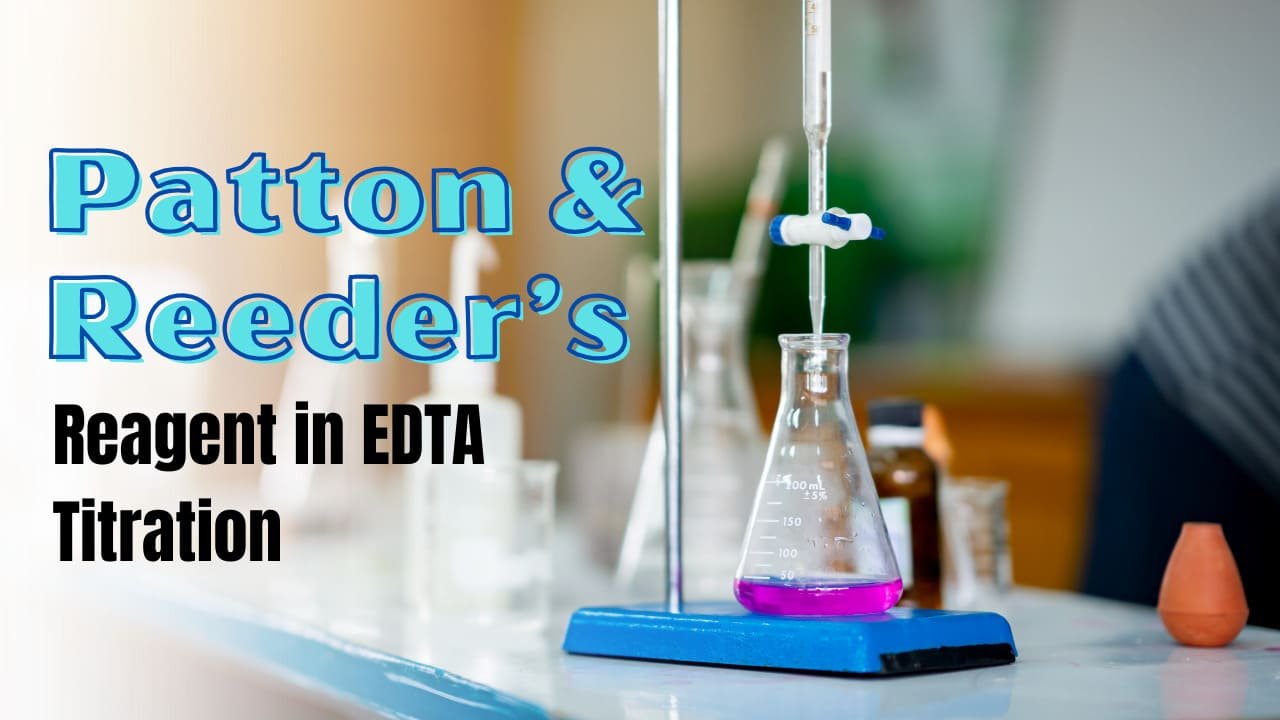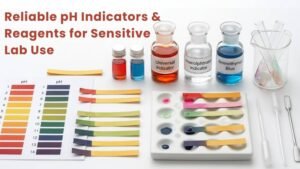Complexometric titration is a widely used analytical technique for determining metal ions in solutions. Among the various indicators used in EDTA (Ethylenediaminetetraacetic acid) titration, Patton & Reeder’s Reagent (PRR) stands out for its high specificity and accuracy in detecting calcium and magnesium ions.
What is Patton & Reeder’s Reagent?
Patton & Reeder’s Reagent (PRR) is a metallo-indicator used in EDTA titration to determine the concentration of calcium (Ca²⁺) and magnesium (Mg²⁺) ions in aqueous solutions. It is particularly useful in water hardness analysis, pharmaceutical quality control, and industrial processes requiring precise metal ion quantification.
Chemical Properties of Patton & Reeder’s Reagent
Chemical Composition- A complex organic dye that forms stable colored complexes with metal ions.
Solubility- Soluble in water and ethanol.
Color Changes-
-
- Forms a red complex when bound to calcium or magnesium ions.
- Turns blue when metal ions are removed by EDTA, marking the endpoint of the titration.
pH Range- Effective in pH 10 – 12, making it ideal for alkaline conditions.
Comparison with Other Indicators

Unlike Eriochrome Black T (EBT), which is commonly used for total hardness determination (Ca²⁺ + Mg²⁺), PRR specifically targets calcium ions, offering greater selectivity in high-alkalinity conditions.
How Patton & Reeder’s Reagent Works in EDTA Titration?
Principle of EDTA Titration
EDTA is a strong chelating agent that forms stable 1:1 complexes with metal ions. In a titration, EDTA progressively binds to available metal ions until all free metal ions are chelated, indicating the titration endpoint.
Step-by-Step Mechanism of PRR in EDTA Titration
- Sample Preparation- The solution containing Ca²⁺ and Mg²⁺ ions is buffered to pH 10 – 12.
- Addition of PRR- PRR is added to form a red complex with calcium ions.
- Titration with EDTA- EDTA is gradually added, binding to free calcium ions.
- Color Change at Endpoint- Once all calcium ions are complexed with EDTA, PRR regains its blue color, signaling the endpoint.
This color transition from red to blue is sharp and easily detectable, enhancing accuracy in calcium ion quantification.
Applications of Patton & Reeder’s Reagent in Laboratories and Industry
PRR is widely used in industries requiring precise metal ion analysis. Some major applications include:
1. Water Hardness Testing
PRR is extensively used in water quality analysis to measure calcium hardness in:
- Drinking water treatment plants.
- Boiler feedwater analysis in industries.
- Aquaculture and agriculture to maintain proper mineral balance.
By accurately quantifying calcium levels, PRR helps in water softening processes and ensures compliance with regulatory standards.
2. Food and Beverage Industry
Calcium content plays a crucial role in food quality and preservation. PRR-based EDTA titration is used in:
- Dairy industry to measure calcium in milk and cheese production.
- Bottled water industry to ensure mineral content consistency.
- Food fortification analysis for accurate calcium supplementation.
3. Pharmaceutical Industry
Precise calcium determination is essential in pharmaceutical formulations, including:
- Calcium supplements to ensure correct dosage levels.
- IV fluids for accurate electrolyte balance.
- Medical research for studying calcium-related metabolic disorders.
4. Chemical and Petrochemical Industry
PRR is used in industrial chemical analysis to measure calcium content in:
- Lubricants and coolants for equipment maintenance.
- Construction materials such as cement and lime.
- Fertilizers to monitor calcium levels for agricultural use.
5. Environmental Monitoring
Environmental scientists use PRR in EDTA titration to track calcium pollution in:
- River and lake water are affected by industrial waste.
- Soil analysis to detect calcium depletion.
- Wastewater treatment plants to optimize removal processes.
Advantages of Patton & Reeder’s Reagent in EDTA Titration
Patton & Reeder’s Reagent offers several advantages over traditional indicators like Eriochrome Black T.
Greater Selectivity for Calcium Ions
- Unlike Eriochrome Black T, which detects both Ca²⁺ and Mg²⁺, PRR is more selective for calcium.
- This selectivity is crucial for industries where accurate calcium measurement is required.
Clear and Sharp Color Change
- PRR provides a distinct red-to-blue transition, making endpoint detection easy and precise.
- Reduces errors in manual titrations, enhancing reproducibility.
Effective in High-Alkalinity Conditions
- Works optimally at pH 10 – 12, making it suitable for solutions requiring high-alkaline stability.
- Minimizes interference from magnesium ions, ensuring accurate results.
Wide Industrial Applicability
- Used across multiple industries, from water treatment to food safety and pharmaceuticals.
- Plays a crucial role in regulatory compliance for water quality and consumer products.
Conclusion
Patton & Reeder’s Reagent has revolutionized EDTA titration methods by providing high accuracy and specificity in calcium ion determination. Its sharp color transition, effectiveness in alkaline conditions, and widespread industrial applications make it an indispensable tool in water analysis, food safety, pharmaceuticals, and environmental monitoring.
As technology advances, innovations in PRR-based titration are expected to enhance precision, efficiency, and sustainability in analytical chemistry.








